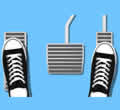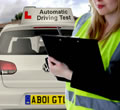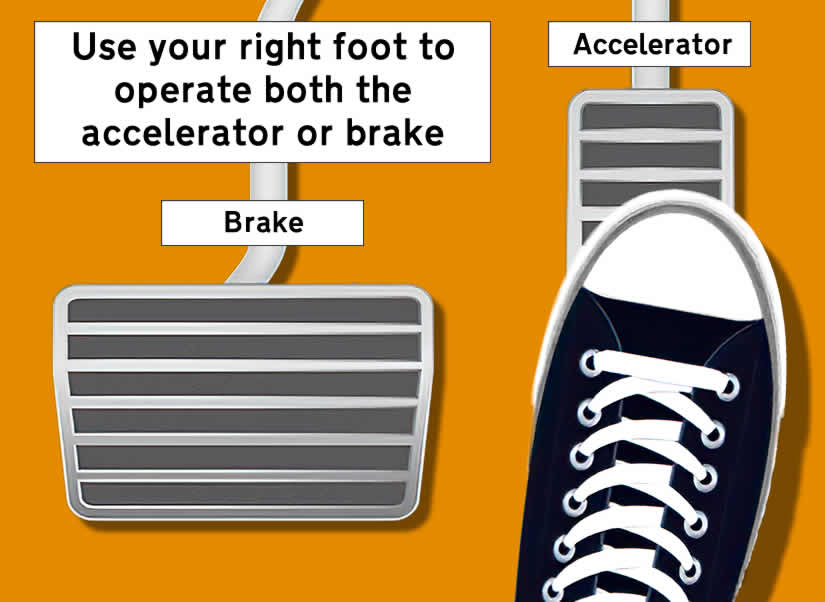The following is what’s considered safe practice for operating the foot pedals in an automatic car:
- For general driving in an automatic car, use only your right foot for operating either the accelerator or brake pedal.
- When carrying out manoeuvres or moving off on a hill in an automatic car, you can use both feet; the right foot to operate the accelerator pedal and the left foot to operate the brake pedal.
General Driving
For general driving in an automatic car, you use only your right foot for operating either the accelerator pedal or the brake pedal as there’s no need to brake and accelerate at the same time. While it is possible to use both feet when driving an automatic car, there are potential hazards associated with it. These include:
- In an emergency situation, you’re at greater risk of fully depressing both the brake and the accelerator.
- Some drivers have a tendency to ‘ride’ the brake pedal. This means that they rest their left foot on the brake pedal. As the brake pedal only needs to be slightly touched to activate the brake lights, the driver may inadvertently activate them.
- Incorrect combined use of both the brake and accelerator pedals can result in conflict, meaning that there’ll be a certain amount of simultaneous braking and accelerating. Over time, this results in greater fuel consumption and brake wear.
- If you have previous experience driving a manual car, you’ll use your left foot to operate the clutch. This means that if you use your left foot to operate the brake in an automatic car, from muscle memory and habit, you may use it as though it’s the clutch pedal.
Carrying Out Manoeuvres or Moving Off on a Hill
The exception to using both feet when driving an automatic car is when you’re carrying out manoeuvres or moving off on a hill. When carrying out a manoeuvre such as parallel parking, parking in a bay etc, greater control over the vehicle’s speed is beneficial. Most automatic cars come equipped with a ‘creep‘ function that allows the vehicle to move at a very slow speed without pressing the accelerator.
You can often carry out manoeuvres using the creep function and the brake pedal only, but if you feel that by using both feet will offer you greater control, it’s perfectly safe to do this at slow speeds.
Moving off on a hill (hill start) in an automatic car is another situation where some drivers prefer to use both feet, though it really depends on the vehicle being used and how steep the hill is. Using both feet, the left foot on the brake and the right foot on the accelerator pedal can be used to help prevent the car from rolling backwards.
However, if the hill isn’t too steep, the creep function might be sufficient to percent the car from rolling backwards and some cars may also come equipped with a hill start assist function that specifically helps in this situation.
![]()
 Foot Position While Driving an Automatic
Foot Position While Driving an Automatic
This tutorial explains the best foot position for driving an automatic car for best comfort to reduce leg ache and to maintain best control of the brake and accelerator pedals.
![]()
 Can You Drive with Two Feet on a Driving Test?
Can You Drive with Two Feet on a Driving Test?
If you are a driver of automatic cars who uses both feet to drive, we explain whether you can use both feet to drive an automatic car on the practical driving test.
![]()

Let foot braking in an auto car is NOT dangerous.
In fact it gives greater control as moving your right foot across to the brake pedal slows the reaction time and because of the different pedal heights (check your own car) the shoe can catch under the brake pedal.
This also goes for a manual transmission (stick shift for you yanks), many race drivers left foot brake using what is called a trailing throttle and brake using a light braking whilst still on the throttle through fast corners – reducing throttle reaction time!
Hi Rick,
The potential danger can occur if you have previous experience driving a manual, where you only use the left foot to operate the clutch. Instinctive reactions can easily see you hit the brake pedal when thinking you need to change gear. Using both feet makes sense for race driving. If your only experience is driving automatics and you’re taught properly, then it becomes less of an issue.
I have driven manual for most of my life (36 of my 53 on earth), but DCT and manuals on track, torque convertors at other points for road use. I can understand why it’s generally recommended to use one foot for people who aren’t invested in their driving, but am pleased to find out it’s not mandated for test purposes.
For any driver it’s important to realise that a typical stress response is for the brain to leave, so would encourage anyone to drill pedal position when you get into a new car, even if you aren’t mixing braking foot. Using two feet for auto’s brings benefits though, particularly in poor/edge of grip conditions as it enables better balance of the vehicle through more progressive weight shift; best understand that if you do mix though, your response under stress may not be as immediately accurate as a unified approach. Practice/drilling and concentration will go a long way to ameliorate that risk.
Rick is a little off in his appraisal of why we generally trail brake into bled in throttle, but the subject is nuanced and not really within the scope of a site aimed at learners.
Hi Matt,
Your points are well made.